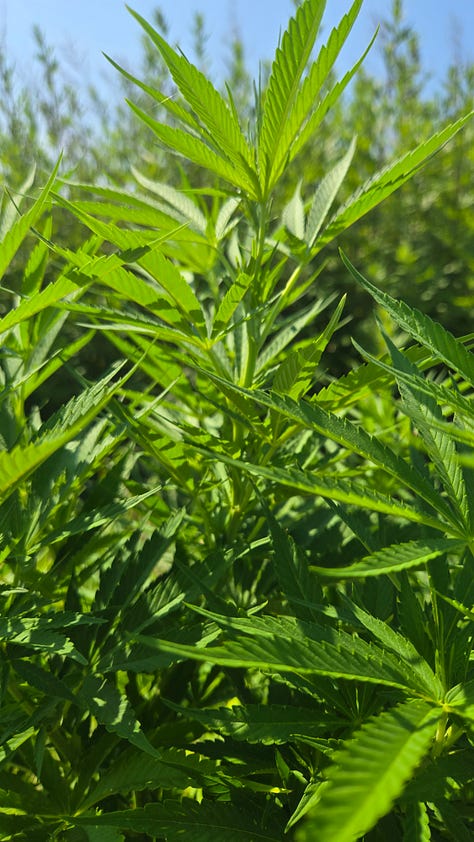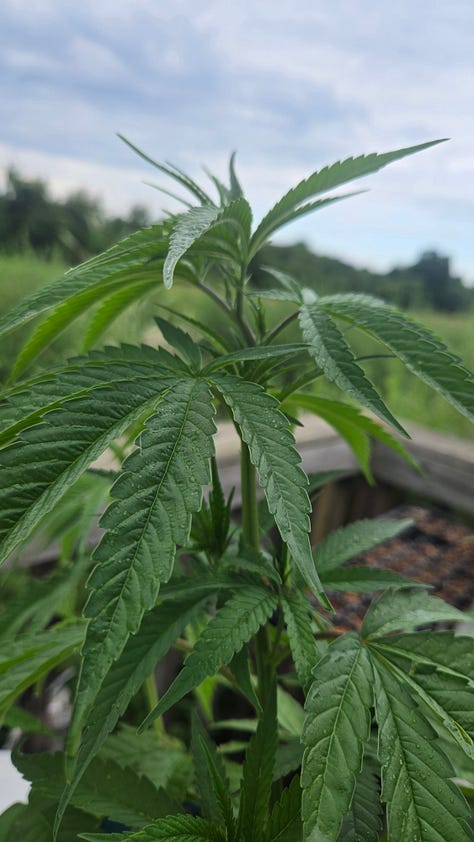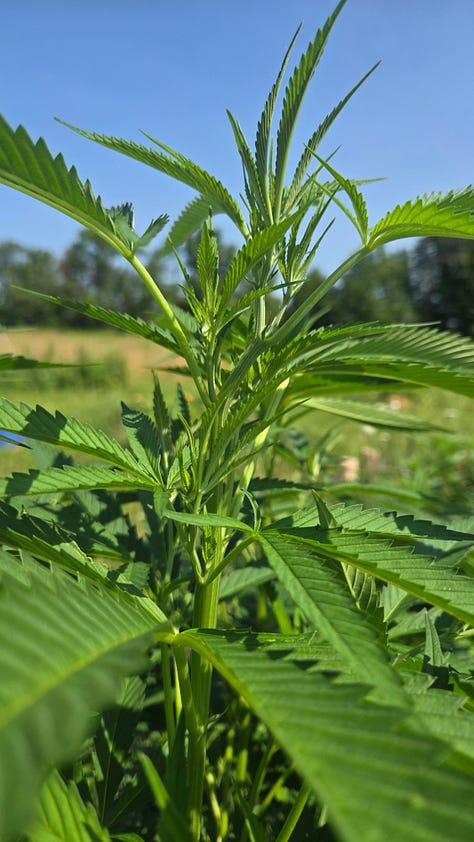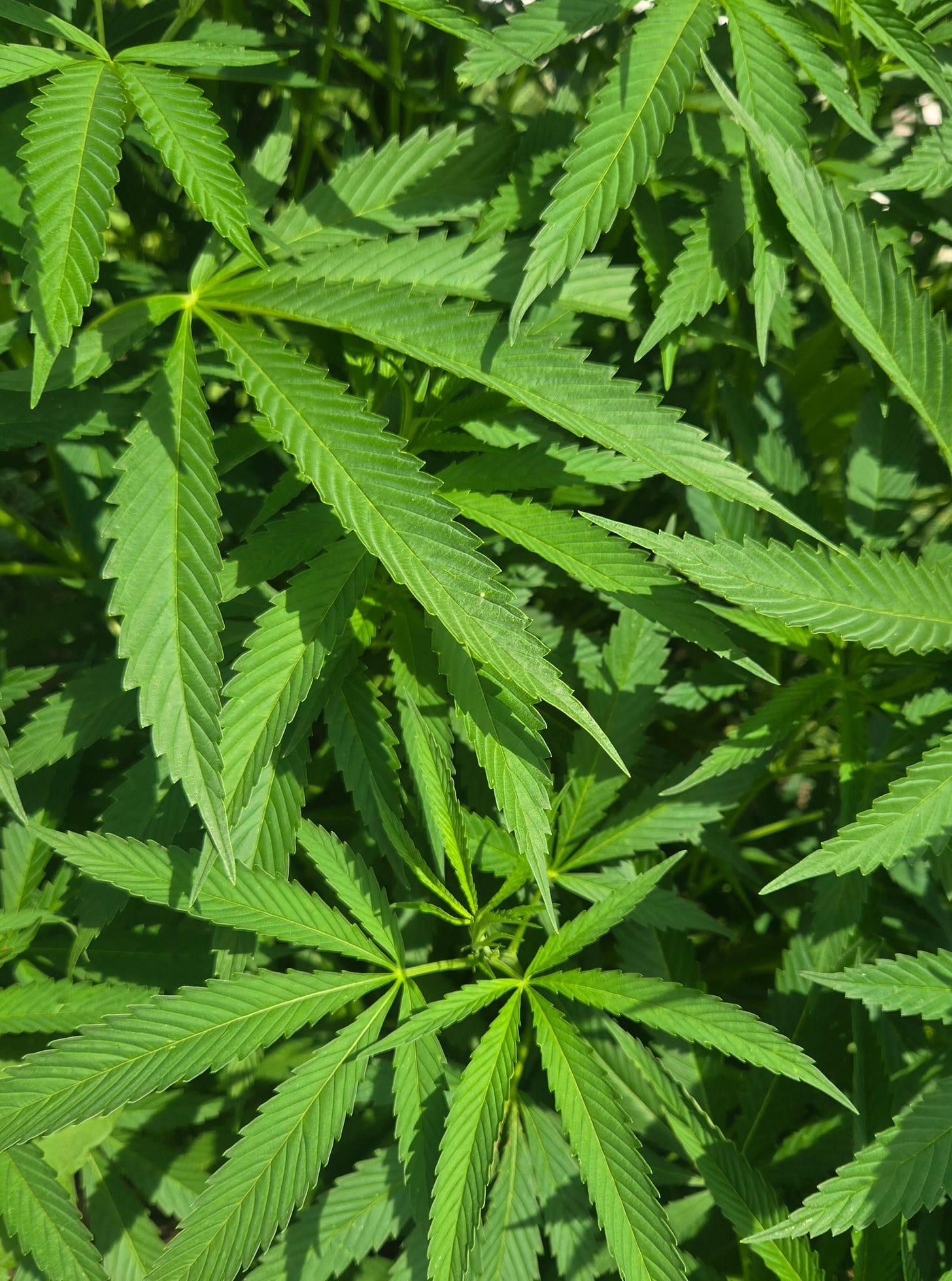Lessons from Tending Cannabis: On Water and Nutrient Balance
As some of you might have figured out in my earlier post, “Whole Plant Medicine and Cannabis,” I think about cannabis a lot… and I do so from a perspective that incorporates my values, political praxis, and deep reverence for the more-than-human world.
I recently had a conversation with some friends that arose from a question related to whether or not some of a comrade’s cannabis plants were overwatered and/or otherwise in need of tending.
What followed was me sharing some neurospicy-special-interest-level info about things I’ve learned about tending plants (and myself, and my relationships, not to mention my spiritual connectivity) as a direct result of tending cannabis plants… and it occurred to me that I should expand upon some of these ideas in some posts here: welcome to the first one!
I am soon going to get into some what have been some truly game-changing insights that cannabis has taught me about how to be a better steward to the many plants friends who grow in my garden and environs: in this post, I am going to specifically focus on clues regarding how to identify whether plants are struggling, and how one might most effectively intervene to help the plant(s) in question.
But first to provide some disclaimers at the onset:
I am not a professional grower. I grow cannabis plants outdoors at a small scale, well within the limits of the laws where I live, and with as much of a focus on CBD-dominant plants as on plants that contain THC. I just happen to do so pretty darned well.
I am not an official, certified organic farmer; everything I do is at way too small of a scale for anything of the sort. Nevertheless, I practice regenerative, organic methods when tending all of my plants, including but not limited to cannabis; I also frequently incorporate biodynamic and permacultural/food forestry principles, not to mention a whole lot of witchiness and magic.
These approaches obviously result in a different approach to tending my plants than that of other folks who grow cannabis. Folks with very disparate growing methods can all grow amazing medicine: please feel free to cross-reference things I share with your own knowledge and existing practices, and discard what doesn’t fit for you.
My approach to tending plants includes, in part, my direct recognition that sometimes my plants will get nibbled by critters and/or exposed to microbes that maybe I wish they weren’t. Nevertheless, I focus on tending to the health of and building up the resilience of the plants themselves—as well as the microbiome and beneficial members of the surrounding ecosystem—not primarily on eradicating pathogens or critters. This results in me making different choices than some other gardeners and farmers would.
I have limited experience with indoor growing, and no experience with hydroponic growing. I say without hesitation or ego attachment that I am not the person to go to for any significant guidance on either topic (although I could connect folks to reliable references and resources on either).
Nevertheless, I do have a deep level of knowledge about cannabis and her gifts, as both a grower and an imbiber. I have also been honored to have learned, over the decades, from others who likewise have deep wisdom regarding tending to and interacting with cannabis and her medicine.
And it is some of the lessons that I have learned through that process that I would like to pass along to all of y’all.
Water Balance and the Newer Leaves
So, yeah. Getting back to my friend’s query about how to tell when cannabis plants are getting too much or not enough water.
This is one thing that cannabis plants are very communicative about. Let me show some examples: I don’t think it will be hard for you all to tell which ones are happy with their water balance and which ones aren’t:






Four of those plants (the first three and the last one) are in perfect, joyful water balance. You can see that it looks like they are literally throwing up their hands and arms in joy, just chuffed to be alive on such a glorious morning.
The other two are perfectly healthy plants... and they are in need of a drink. You can see that they aren't by any means cranky or sick, they just don't have it in them to be quite so enthusiastic as the other ones (which, like... I get it: we all have mornings like that). Their top leaves are more in a rainbow-shaped arc than they are thrown upward in exhilaration.
The difference between the angle/cast of the upper leaves of plants is most apparent in the morning: it is common for all plants, happily watered or not, to have a bit more of a “rainbow” cast to them by the end of the day, versus the exuberance they may have felt earlier in the day.
(Again: relatable.)
This is a great example of the realization, gifted to me as a result of the time I have spent working closely with and learning from cannabis, that is going to guide the rest of this post:
In general—and yes, I will go into some exceptions in a bit—plants first communicate that they are out of water balance through changes in their newer leaves, and first indicate that they are navigating nutrient deficiencies through changes in their older leaves.
Once one really starts looking at/listening to their cannabis plants by paying attention to the angle of their newest leaves, it becomes clear that these uppermost leaves are (among other things) the communicators of the plants’ current water balance.
[The frowny-face leaf posture is the same if they are over watered OR under watered: context clues (what the weather has been, the weight of the pot, etc) tell you which one.]
One of my cannabis-growing mentors, Tammi Sweet, notes in her book The Beginner’s Guide to Growing Cannabis and Making Your Own Healing Remedies that a “common beginner mistake is to over-water early in the plant’s life cycle and under-water later.”
The importance of avoiding over watering early in a plant’s life is particularly crucial because when a young plant is in soil that is too waterlogged, they can't access the nutrients in the soil... not because the nutrients aren't there, but because the soil is too heavy for them to reach them with their finest little baby root fibers: they're just not up to that level of strength training yet.
(This is why a lot of gardeners will work in some amount of perlite, vermiculite, or straw into their potting soil, and/or incorporate companion plants who will help keep the soil from getting too compacted in their containers and garden beds.)
The same effect also happens during particularly rainy periods, independent of the gardener's enthusiasm or restraint... which of course is one of the benefits of having at least some of one’s plants in containers that can be moved in response to the weather conditions (an impossibility to do for the ones who are rooted in the soil).
It is a natural tendency to want to tend to baby plants' every need and prevent them from ever experiencing a moment in which a single one of their wants and preferences isn't fulfilled... hence the tendency to over water when they're young.
We know what sort of humans result from being raised in such environments, and something similar can result in plants: plants who are not exposed to the wind have weaker stems and branches. Plants who never have variations in their water levels tend to be less drought resistant (eta and often have less robust root systems). Plants who are not in relationship with beneficial microorganisms and critters are more susceptible to significant harm from harmful pathogens and critters.
My general practice is to wait until a plant's leaves look like the two less enthusiastic ones before watering, water them thoroughly at that point... and then wait until they tell me they need more to give them more.
In order to take this lesson and apply it to plants other than cannabis, there are a few key points to keep in mind:
It is important to understand the growth patterns of the other plants in question: while it is true that for many plants (including cannabis, tomatoes, hops, lemon balm, etc. etc.) the newest leaves will be the ones toward the top of the plant, other plants (e.g., chard, parsley, rhubarb, alliums, etc.) grow their newest leaves toward the center of the plant.
While cannabis communicates water imbalance through the angle of her leaves, other plants may do so through curling their leaves in toward the center, putting on new growth more slowly, or having new growth displaying a different color/vibrancy.
Nutrient Balance and the Older Leaves
Okay, so the observation I made earlier about plants communicating nutrient deficiencies through observable changes in their older leaves has layers and nuance, and by necessity given the scope of the article is somewhat oversimplified… so don’t everyone come at me all at once!
Nevertheless, this pattern is evident often enough that it can provide helpful guidance in tending to our plants, despite the admitted exceptions to the pattern that exist.
(I also will be going into some of the main exceptions and limitations of this pattern in a bit, so hold your horses if they’re already chomping at the bit to correct me.)
To quote from the book Feminist Weed Farmer: Growing Mindful Medicine in Your Own Backyard by Madrone Stewart (yes… the copy I mentioned in a previous post that I had ordered has arrived, and I’m loving diving into it: it is highly recommended!):
Cannabis plants are extremely heavy feeders, and you will need to be vigilant in your feedings. I suggest keeping your eyes on the lower leaves, or the skirt. If those leaves are bright green, you are fertilizing enough. If they start to lighten and turn yellow, the plant needs more nitrogen rich fertilizer. If the skirt turns dark green and the tips turn yellow, you have overfertilized. Finding the sweet spot is difficult and will be different for each strain [cultivar]. As plants grow, their need for fertilizer shifts…. You will need to get to know your plants well and try to meet the needs that they are indicating with their lower leaves.
Many people will feel an impulse to rush in and remove the lower fan leaves that have started to yellow, but I caution people away from doing so. Part of their reason for existence—alongside photosynthesis and beauty—is to help nourish the plant. When the plant starts drawing in the nutrients from the lowest fan leaves, that is the plant doing what it is meant to do in order to support the flourishing of the overall system.
If someone were to vigilantly remove lower fan leaves at the first sign of yellowing, they will be frustrated to notice that the pair(s) of fan leaves one level up will soon be yellowing, too… because the plant is doing what they need to do in order to grow into their abundance.
It is a much better practice to leave the yellowing leaves on until they are completely yellow: this means that the plant has gotten what nourishment from the fan leaf that it had to offer, and the leaf can now be removed without depriving the plant of any nourishment.
Now that this pattern has been named, start to look for it in the plants in your garden (cannabis and non-cannabis alike): check out their older leaves for differences in their coloring and texture for clues they might be offering to you about possible nutrient imbalances!
[As mentioned earlier, note that some plants (such as cannabis) have their older leaves toward the bottom of the plant, while other plants (such as chard, cilantro, and rhubarb) have their older leaves toward the outside of the plant.]
And, for those who are curious: When the lower leaves on a plant start yellowing, recommended organic, sustainable interventions include foliar spraying with compost tea, fermented plant tea, and/or worm casting tea as well as top-dressing the soil with compost and/or worm castings.
Exceptions and Limitations of the Pattern
Okay, okay, I know: there are two very important things I need to name overtly:
Not every color or texture change on the lower/older leaves of a plant indicates nutrient imbalance.
Many of the pathogens that are most likely to pose a threat to plants live in the top layer of the soil: then, when conditions are particularly rainy or humid, the spores can multiply and travel in the air.
The leaves that these spores are most likely to land on are the ones that are most accessible: the lowest and outermost leaves.
As such, fungal infections including leaf septoria and powdery mildew are also most likely to be initially evident on the older leaves of a plant.
Not every nutrient imbalance is first visible on the lower/older leaves of a plant.
As noted by Jeorge Rosenthal in Marijuana Horticulture, there are nutrient imbalances that first reveal themselves in leaves other than the oldest ones; for example, calcium deficiency frequently first appears in the set of leaves just above the bottom set, while magnesium deficiency may first appear in the “middle-aged leaves.”
Even with these limitations, though, the general guide of watching the younger leaves of your plants for clues about their hydration levels and the older leaves of plants for clues about their nutrient balance has proven to be a very helpful shorthand in assisting me determine what to try first when helping my plants live their best lives.
It is through the teachings about cannabis that I have received through the years that I knew to watch for these patterns in cannabis plants… and it was the quality of attention that cannabis inspires within me that helped me to see these patterns echoed throughout the garden and prairie.
I swear that she is such a loving mentor plant that she starts offering her lessons from seed, for those who listen and build relationship with her.




